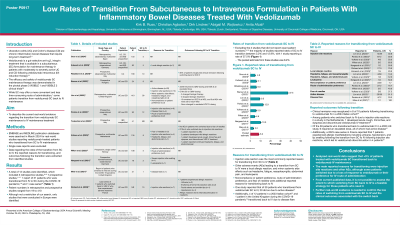Sunday Poster Session
Category: IBD
P0917 - Low Rates of Transition From Subcutaneous to Intravenous Formulation in Patients With Inflammatory Bowel Diseases Treated With Vedolizumab
Sunday, October 27, 2024
3:30 PM - 7:00 PM ET
Location: Exhibit Hall E

Has Audio

Abigail M. Wojtowicz, PhD
Takeda
Cambridge, MA
Presenting Author(s)
Kirk B.. Russ, MD1, Christian Agboton, MD2, Dirk Lindner, MSc3, Abigail M.. Wojtowicz, PhD2, Anita Afzali, MD, MPH, MHCM, FACG4
1University of Alabama at Birmingham, Birmingham, AL; 2Takeda, Cambridge, MA; 3Takeda, Zurich, Zurich, Switzerland; 4University of Cincinnati College of Medicine, Cincinnati, OH
Introduction: Vedolizumab (VDZ) is available in subcutaneous (SC) formulation for maintenance therapy in patients with moderately to severely active ulcerative colitis and Crohn’s disease following VDZ intravenous (IV) induction therapy. The efficacy and safety of VDZ SC maintenance was demonstrated in the pivotal phase 3 VISIBLE clinical studies. Real-world evidence supports the effectiveness and persistence of VDZ SC treatment; however, some patients transition back to IV maintenance.
Methods: We aimed to describe real-world evidence of the transition from VDZ SC maintenance to IV maintenance. EMBASE and MEDLINE were searched (13 March 2024) for real-world studies, excluding case reports, that reported patients who transitioned from VDZ SC to IV maintenance. Data on patient proportions and reasons for the SC-IV transition were extracted.
Results: Eleven publications met prespecified search criteria. Rates of transitioning from SC maintenance back to IV maintenance ranged from 3.2% to 12.9%, with an overall rate of 7.4%. The most commonly reported reasons for SC to IV transition were injection site reactions, unspecified AEs, allergic reaction, fear of needles and preferred route of administration (ROA). Four of 12 patients who transitioned back to IV in a 2023 Italian cohort did so due to disease flare. Additionally, among 31 UK patients who transitioned to SC during the COVID-19 pandemic, 1 transitioned back to IV due to disease flare. In a 2023 Italian cohort, 24/168 patients experienced disease relapse following IV to SC transition, 10 of whom transitioned back to IV treatment and 8 then recaptured clinical remission. A 2022 UK study reported 12/164 patients transitioned from SC back to IV, 4 at an escalated dose, and 1 experienced an anaphylactic reaction upon restarting IV. A 2023 case series reported that 7 patients experienced allergic manifestations following the transition from SC to IV, which led to VDZ discontinuation in 4 patients.
Discussion: Real-world data suggest low rates of transition back to VDZ IV from SC maintenance, and those that transition do so mainly due to injection site and allergic reactions and preferred ROA, rather than a loss of response. It is not possible to assess from current published data the extent to which infusion reactions or loss of response occur when transitioning back to IV maintenance. Further real-world evidence is needed to confirm the low rates of switching from VDZ SC to IV noted in these summarized studies.
Disclosures:
Kirk B.. Russ, MD1, Christian Agboton, MD2, Dirk Lindner, MSc3, Abigail M.. Wojtowicz, PhD2, Anita Afzali, MD, MPH, MHCM, FACG4. P0917 - Low Rates of Transition From Subcutaneous to Intravenous Formulation in Patients With Inflammatory Bowel Diseases Treated With Vedolizumab, ACG 2024 Annual Scientific Meeting Abstracts. Philadelphia, PA: American College of Gastroenterology.
1University of Alabama at Birmingham, Birmingham, AL; 2Takeda, Cambridge, MA; 3Takeda, Zurich, Zurich, Switzerland; 4University of Cincinnati College of Medicine, Cincinnati, OH
Introduction: Vedolizumab (VDZ) is available in subcutaneous (SC) formulation for maintenance therapy in patients with moderately to severely active ulcerative colitis and Crohn’s disease following VDZ intravenous (IV) induction therapy. The efficacy and safety of VDZ SC maintenance was demonstrated in the pivotal phase 3 VISIBLE clinical studies. Real-world evidence supports the effectiveness and persistence of VDZ SC treatment; however, some patients transition back to IV maintenance.
Methods: We aimed to describe real-world evidence of the transition from VDZ SC maintenance to IV maintenance. EMBASE and MEDLINE were searched (13 March 2024) for real-world studies, excluding case reports, that reported patients who transitioned from VDZ SC to IV maintenance. Data on patient proportions and reasons for the SC-IV transition were extracted.
Results: Eleven publications met prespecified search criteria. Rates of transitioning from SC maintenance back to IV maintenance ranged from 3.2% to 12.9%, with an overall rate of 7.4%. The most commonly reported reasons for SC to IV transition were injection site reactions, unspecified AEs, allergic reaction, fear of needles and preferred route of administration (ROA). Four of 12 patients who transitioned back to IV in a 2023 Italian cohort did so due to disease flare. Additionally, among 31 UK patients who transitioned to SC during the COVID-19 pandemic, 1 transitioned back to IV due to disease flare. In a 2023 Italian cohort, 24/168 patients experienced disease relapse following IV to SC transition, 10 of whom transitioned back to IV treatment and 8 then recaptured clinical remission. A 2022 UK study reported 12/164 patients transitioned from SC back to IV, 4 at an escalated dose, and 1 experienced an anaphylactic reaction upon restarting IV. A 2023 case series reported that 7 patients experienced allergic manifestations following the transition from SC to IV, which led to VDZ discontinuation in 4 patients.
Discussion: Real-world data suggest low rates of transition back to VDZ IV from SC maintenance, and those that transition do so mainly due to injection site and allergic reactions and preferred ROA, rather than a loss of response. It is not possible to assess from current published data the extent to which infusion reactions or loss of response occur when transitioning back to IV maintenance. Further real-world evidence is needed to confirm the low rates of switching from VDZ SC to IV noted in these summarized studies.
Disclosures:
Kirk Russ indicated no relevant financial relationships.
Christian Agboton: Takeda – Employee, Stock Options.
Dirk Lindner: Takeda – Employee, Stock Options.
Abigail Wojtowicz: Takeda – Employee, Stock Options.
Anita Afzali: AbbVie – Consultant. Bristol Myers Squibb/Celgene – Consultant. Cullgen – Consultant. DiaSorin – Consultant. Eli Lilly – Consultant. Gilead – Consultant. IBD Horizons – Consultant. Janssen – Consultant. Pfizer – Consultant. Takeda – Consultant. TLL Pharmaceuticals – Consultant.
Kirk B.. Russ, MD1, Christian Agboton, MD2, Dirk Lindner, MSc3, Abigail M.. Wojtowicz, PhD2, Anita Afzali, MD, MPH, MHCM, FACG4. P0917 - Low Rates of Transition From Subcutaneous to Intravenous Formulation in Patients With Inflammatory Bowel Diseases Treated With Vedolizumab, ACG 2024 Annual Scientific Meeting Abstracts. Philadelphia, PA: American College of Gastroenterology.
